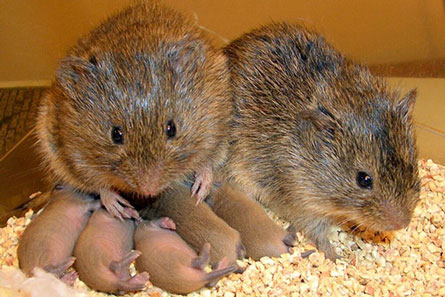Archived Content
The National Institute of Mental Health archives materials that are over 4 years old and no longer being updated. The content on this page is provided for historical reference purposes only and may not reflect current knowledge or information.
Brain Circuit Tweak Wins Her Affection (if she’s a vole)
Previously unknown mechanism underlying pair bonding behavior discovered
• Science Update
For the first time, NIMH-funded neuroscientists have boosted a female rodent’s partnering with a male by stimulating connectivity of a brain reward circuit. In a monogamous female vole socializing with a male, the researchers tuned-in to electrical communications in two sites known to be critical for reward processing and social bonding. They discovered telltale signals associated with increases in vole pair bonding behaviors, such as choosing to spend more time together “huddling.” They then optogenetically stimulated neurons in the female’s circuit during a social interaction that does not normally lead to pair bonding. This brain stimulation alone expedited huddling behavior. Increasing activity in the circuit caused a shift toward stronger social bonding. Prior to the study, the researchers knew that the hormone oxytocin worked via receptors in the circuit to trigger such behaviors. Results from this study suggest that individual differences in chemical messenger systems, such as oxytocin, “could underlie how strongly this circuit is activated to promote an enduring bond,” suggest the researchers. Understanding the circuitry of such affiliative behaviors may lead to improved treatments for social impairment in mental disorders. A research team led by NIMH grantees Drs. Robert Liu and Larry Young of Emory University reported on their discovery May 31, 2017 in the journal Nature.

Source: Robert Liu, PhD, Emory University
For more information
Emory researchers closer to cracking neural code of love
Emory University press release
Reference
Dynamic corticostriatal activity biases social bonding in monogamous female prairie voles. Amadei EA, Johnson ZV, Jun Kwon Y, Shpiner AC, Saravanan V, Mays WD, Ryan SJ, Walum H, Rainnie DG, Young LJ, Liu RC. Nature. 2017 May 31. doi: 10.1038/nature22381. [Epub ahead of print] PMID: 28562592
Grants
MH100023, MH097187
